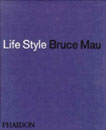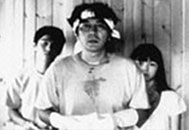THE SUPER 8
Mary Glucksman tallies the grosses.
 |  |  |
| left to right: Versace by Meisel; Life Style by Bruce Mau; Shinji Aoyama's Eureka.
| ||
1. Camarades.com recognizes as Hitchcock did in Rear Window, that its fun to watch, and that the most banal subjects can be the funniest of all. Unlike overtly sexual Web-cam sites, Camarades.com advertises itself as "Webcam Community," offering a buffet of thumbtack images that will click you right into someone’s office, their bedroom, their backyard, their empty foyer and let you watch them staring off into space, chewing on a pencil, scratching their arm. 1,000 windows into private worlds where something is also just about to happen.
2. Versace by Meisel. Versace’s latest ads by Steven Meisel – author Michael Gross once quipped, could have been the love child of Andy Warhol and Richard Avedon – are at once vicious and deeply moving. Bearing the grandeur of 19th century portraiture, the ads present hideously wealthy women in hideously decorated homes wearing hideously fashionable Versace, all just to die for, if they didn’t already seem to be embalmed.
3. Dream of Light. Victor Erice’s three films in 30 years include the piercing childhood reverie, The Spirit of the Beehive and 1992’s Dream of Light (El sol de membrillo), just rereleased by Facets Video. It’s one of the great documentaries, patient and poetic as it captures Madrileño artist Antonio López Garcia painting a quince tree in his courtyard as it ripens. Light changes across a day, then weeks. Months pass; the tree sheds its leaves, fruit ripens, rots. The painting may be abandoned. When is art finished? "The idea underlying this film is simple," Erice wrote. "[To capture] the drawing and painting of a tree." López explains, "A painting is never finished. It is always open ... You can only paint a couple of hours every day, a few weeks every year, since the light changes, and with it the complexion of the landscape. You have to stop at the limit of this change, whatever the state of the painting."
4. Sounds of a Different Realm. From the squish of quivering zygotes beneath a tap dancer’s heel to the steam-leaking radiation of a grind-organ’s final wheeze, the late sound designer Alan Splet’s collaborations with David Lynch forever changed the audio landscape of independent film. Splet’s widow and longtime collaborator Ann Kroeber maintains his legacy and, through this pricey but plentiful software compilation from her company, Sound Mountain, makes it available to a new generation of audio anarchists. "Ethereal presences, ambient hums, swirling winds, gaseous presences and industrial pulsing" – all ready to be tweaked and twisted to your eardrum’s content. ($295, available from hollywoodedge.com.)
5. Life Style. Rem Koolhaus designs buildings, but when it came time to make his now classic book, S, M, L, XL, he found a collaborator in Toronto-based Bruce Mau. Now Mau has produced Life Style, 624 pages of his own thoughts – juxtaposed with large-format pictures and designs – on the current "global-image economy." Recognizing the extent to which a surplus of contemporary graphic ingenuity has created its own surburban sprawl, Mau envisions various counterpractices and embeds them in book designs for publishers Zone, further collaborations with Koolhaus, and even a print version of Chris Marker’s classic sci-fi short La Jetee, all discussed and reprinted here. At its most basic, Mau’s work is wildly cinematic, which is appropos of his own particular critique: "With our newfound manipulative capacities we have rushed blindly toward the idea, a thin digital strip of perfection. Montage is now deliriously self-inflicted."
6. Long slow movies. In charting the shift of hipster interest from artists such as Hans Jürgen Syberberg to Quentin Tarantino, Kurt Andersen once wrote in the New Yorker that because work in the ’70s and ’80s was simple, art had to be hard. Conversely in the ’90s, work, with its new technologies and economies, became hard, so art had to become a little easier. So what does that say about our new century that long, slow movies, with their slumbering montages and anticonsumerist time requirements, are creeping back into vogue? First, Béla Tarr’s seven-and-a-half hour squint at Hungarian peasant betrayal, Sátántangó, showed up on various "best of the decade" lists and played selective repertory spots. And now comes Shinji Aoyama’s nearly four-hour depiction of alienated post-traumatic youth, Eureka, released this fall by the Shooting Gallery. Take off work and realize the Ruizian sublimity of dozing in the theater and waking up refreshed yet confused by the images in front of you.
7. Faust. Everything goes in and out of fashion, right? Not Faust, the anarchic German band whose first incarnation has always influenced the day’s most vital musicians. And although the jury may be out on the reformed group’s prolific new recordings, the ’70s work, as heard on "The Faust Years," a five-CD box from Wimme records, remains a Rosetta stone for everyone from contemporary industrialists to Chicago post-rockers.
8. Vindigo. We are all bits of information, but how does the electron get the advantage whirling around a chosen nucleus? Vindigo (www.vindigo.com) is a free downloadable application for handheld organizers that turns cities into relentless hyperlinks. (It’s even GPS-ready for early adopters.) Seventeen cities are logged on, so choose an intersection and Vindigo obliges with concise food, drink and shopping details within a selected distance. Directions, phone numbers and even today’s movie showtimes are available if you sync the organizer weekly. When Vindigo truly takes off, it will surely be ridden with clever turns that are actually cold-hearted ads, but for now, it’s a metropolis in a shirt pocket, a Sim City simulation of all the reality you can stand.
VOD CALENDAR


 See the VOD Calendar →
See the VOD Calendar →


